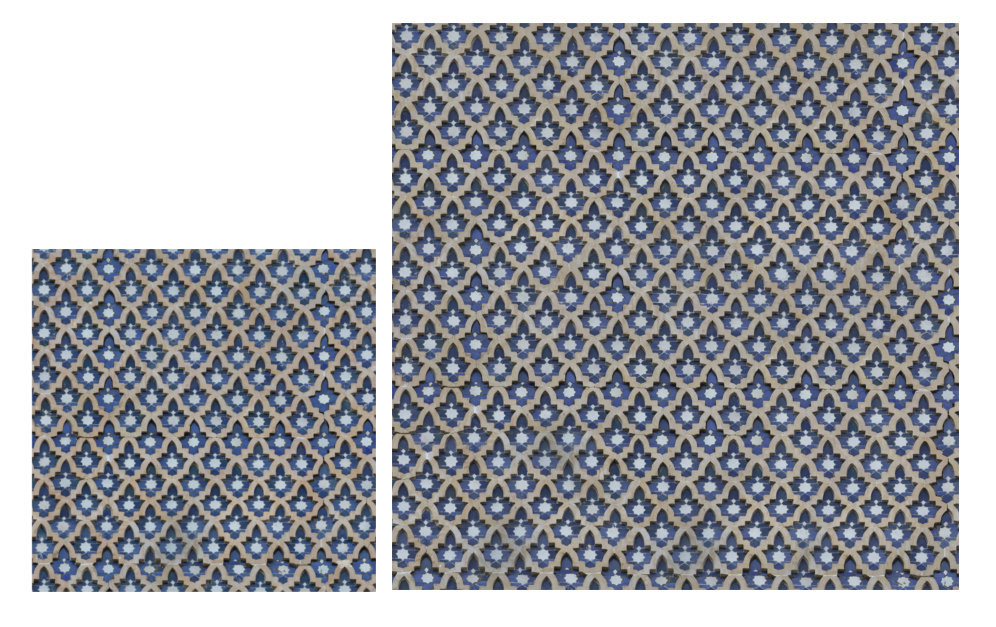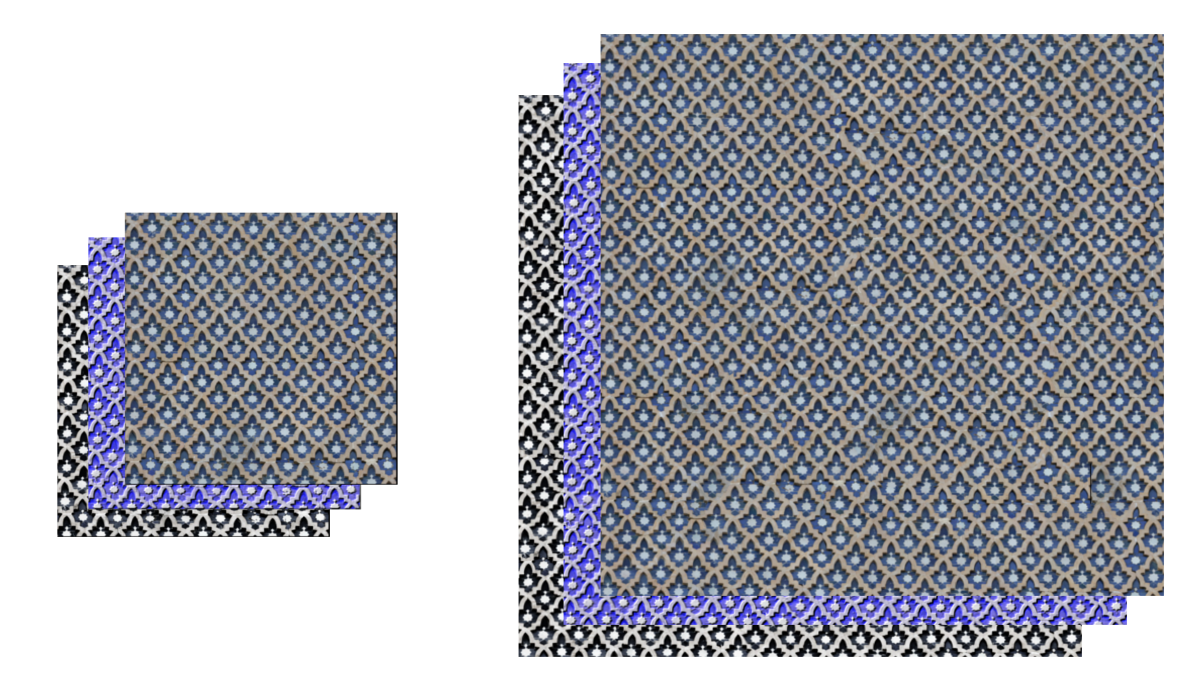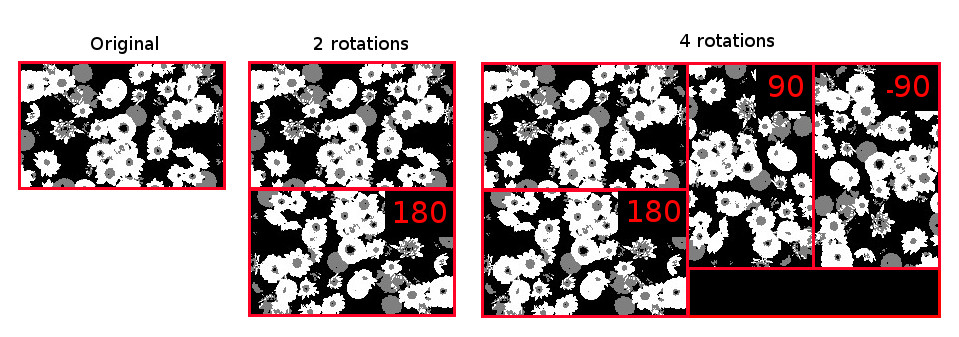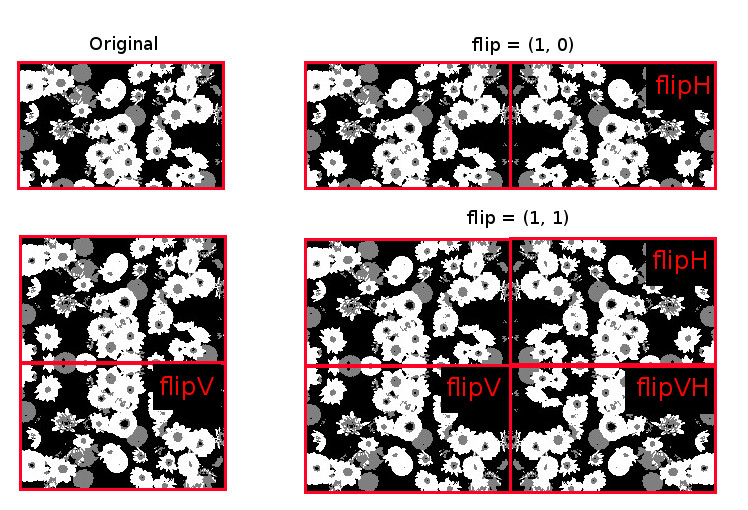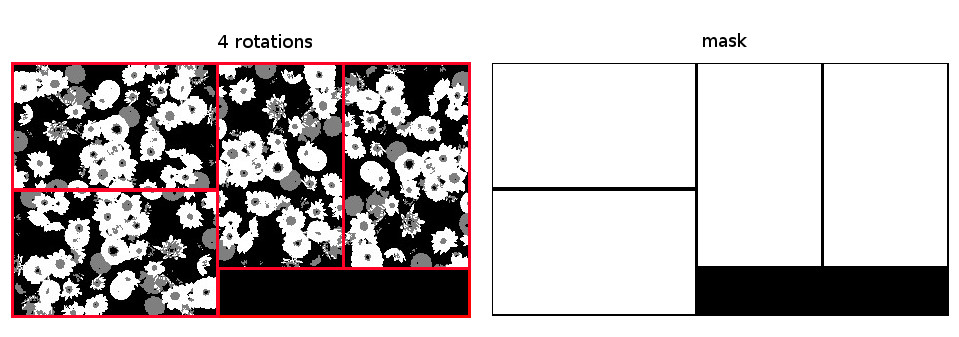Copyright 2016 Pixomondo LLC.
This software is licensed under the GPL.
Quilt is a tool to create a bigger texture from a small one. Instead of patching the input texture and then manually removing seams and repetitions, this tool automatically breaks the texture into small tiles and seamlessly recombines them in the output image; doing so the original texture structure is preserved and repetitions are hard to notice.
The output texture is created by composing overlapping tiles from the input texture in the following way: Given the already-placed tile B1, we choose the tile B2 as the best matching tile (or a random choice among the best matching tiles), that is the tile with most similar overlapping area. Once found, we cut the two tiles on the pixels that match the best. To do that we compute the minimal cut in the overlapping area and cut the tiles accordingly. In this way no seam will be visible.
If a patch has already been placed in the output image, the adjacent patch is found in the following way:
- consider the overlap area of the already placed patch
- compute the distance between this overlapping area and the source image. The distance is computed through the sum of squared differences sum( (img-overlap)^2 ) = sum(img^2) + sum(overlap^2) - 2*img*overlap which in this implementation is expressed through Einstein summation (see ssd.py)
- consider the minima of the so-found distance matrix, that is the values < (minimum + error). In this way, the amount of error controls how accurate is the choice of the new patch (whose overlap area is very similar to the already placed one), versus how much variety is accepted.
Quilt is a command line tool. The only required argument is the path to the input texture. E.g.:
quilt C:/data/image.jpg
Basic parameters:
- tilesize: size of the tiles, i.e. units of the texture synthesis process (default: 30).
- overlap: amount of overlap between two tiles (default: 10). Note: the bigger the overlap the slower, but the less seams will be visible in the texture. Overlap value should be > 0, < (tilesize/2).
- error: amount of error accepted in the selection of the tiles. A small error (e.g. 0.002) reduces the probability of artifacts, but increase the one of repetitions, while a big error (e.g. 0.5) leads to the opposite behaviour.
- output_width and output_height: width and height of the output image.
- destination: path to the folder where to store the output. If not specified, the folder of the input file is taken. Output file name: <input_file_name>_result.png
Additional basic parameters:
- input_scale: scale to apply to the input texture before launching the quilting computation. This parameter is useful when the input image is big, and it would take a long time to compute, or when the desired level of details of the output image is smaller (or larger) than the one of input image. (default: 1)
- constraint_start: constrain the first tile (up left corner) to be the same of the input image
-
multiple images: it is possible to provide a list of related images (color, bump, spec, etc) as input. The computation of the first one will be extended to the following: the output will be a set of images with the same mutual relations (color, bump. spec, etc.). How: provide a generic path.
quilt C:/data/tiles/tiles*.jpgthis will indicate to consider all the images in the folder whose name respect the given pattern (e.g. tiles.jpg, tiles_bump.jpg)
-
remove areas: it is possible to provide a mask (black and white image) of the input texture where black regions indicate areas that should not appear in the result, while areas to be considered are left white. It can be used to remove areas that would appear repeating in the output image (e.g. a brick of a different color in a brick wall). Before starting the computation, the given mask is edited in the following ways:
- "white" values are replaced with 0, while "black" (masked) values are set to infinite. In this way, during the patch matching step, the mask is summed to the distance matrix before searching for its minima. Doing so, masked values (infinite values) are not chosen.
- every masked area is expanded in order to prevent the algorithm to choose all tiles that contain at least one masked pixel.
How: add the option --input_mask followed by the masks's path.
quilt C:/data/tiles/tiles*.jpg --input_mask C:/data/mask.jpg -
output boundaries: it is possible to provide a mask (black and white image) of the output image where white regions indicate areas to cover with texture, while back areas are desired to be filled with background. How: add the option --cut_mask followed by the masks's path.
quilt C:/data/tiles/tiles*.png --cut_mask C:/data/mask.jpgNotes:
- in this case it is necessary that the input image contains some background regions. In order to have better results, the background has to be just one flat color, possibly distinct form the foreground color (e.g. black or white).
- the boundaries are an indication, they will not be precisely reproduced.
In order to get more variations in the output image it is possible to source the tiles not only from the input image, but also from rotated or flipped versions. Command line parameters:
- rotations: number of rotations of 90 degrees to apply to the input image before the computation. Possible values are: 0, 2 (0' and 180') and 4 (0', 90', 180', 270'). (default: 0) If this option is selected, a new source image is created, combining together the input image and its rotation/s. The images are organized as shown in the drawing (the extra area in the four rotations is left at 0):
- flip: boolean tuple for (flip_vertical, flip_horizontal). The image if flipped in the following way:
When rotation or flip is performed, an input mask is created which masks the empty areas and the edges between the images in the source. In this way, no patch containing parts of different images is be sourced during the synthesis process. Here is an example of mask derived from a four- rotation. Notice that if the user provides a custom input mask, the two are added together.
Usage notes:
- the applicability of these features is strictly related to the nature of the input texture: usually, if the texture is oriented (anisotropic) the use of these features is not advised.
- these feature slow down the computation time.
It is possible perform a single process computation or a multi-process computation.
The first process computes quilting with big tiles. Once done, it creates new processes (one per available core) and assigns a big-tile to each of them. Each sub-process then performs the quilting computation with regular-sized tiles. Once all the big tiles have been processed, the results are seamlessly patched. Command line parameters:
- multiprocess: performs the multiprocessing computation (default: True)
- cores: number of cores available for quilting (default: number of cores in the machine minus two)
- big_tilesize: size of the big tiles. Note that if the number of big tiles that fit in the destination image (considering overlapping) is the same of cores, a better performance will be achieved. (default: 500)
- big_overlap: size of the overlap for the big tiles. (default: 100)
Logging is currently to stderr only. It is customized to allow colored output, and to use a queue so that logging can be gathered from multiple processes.
